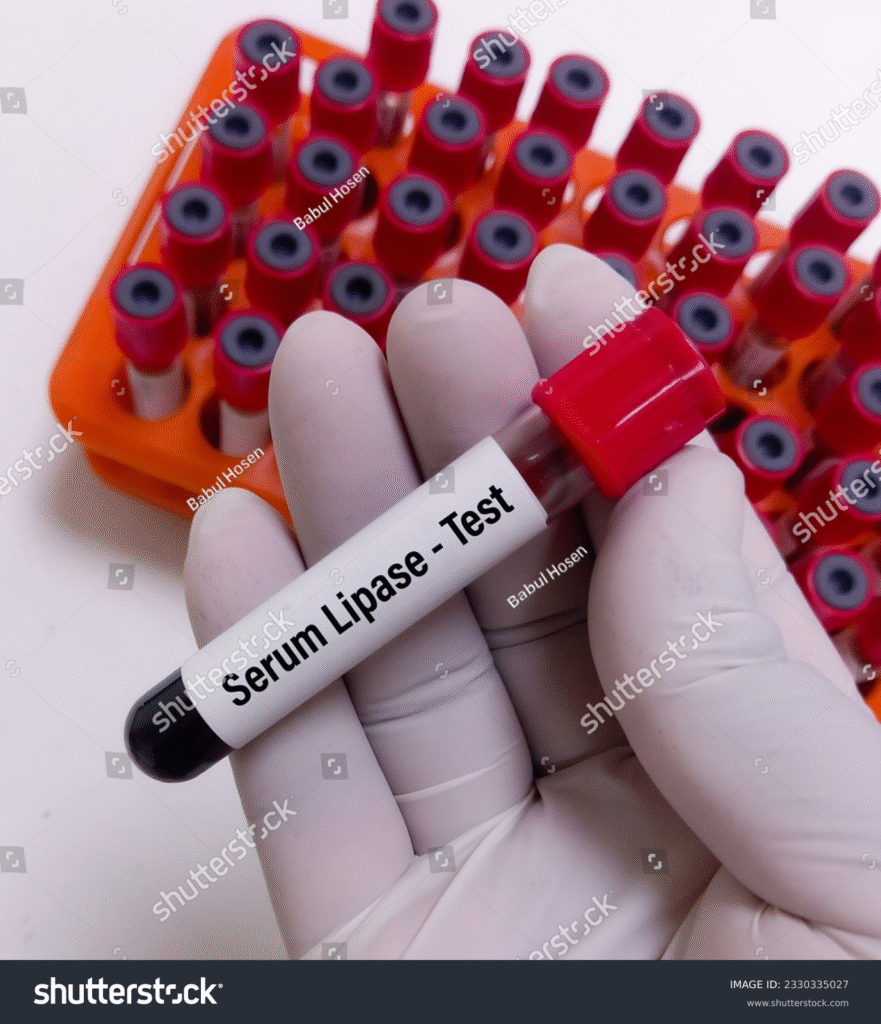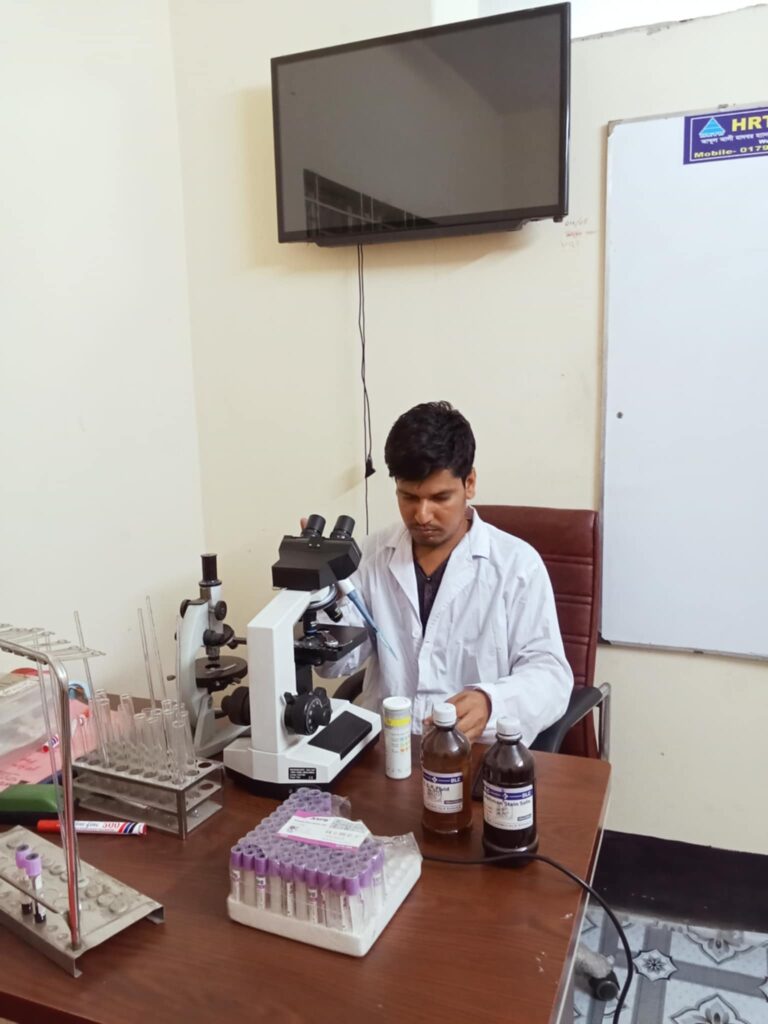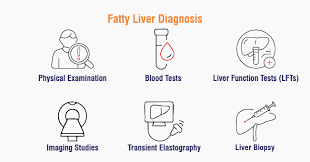Serum Lipase Test 01797522136
1. Introduction
Enzymes play an essential role in the biochemical processes of the human body, serving as catalysts for metabolic reactions. Among these enzymes, lipase is a key enzyme responsible for the hydrolysis of dietary and stored lipids. The serum lipase test is a critical diagnostic tool used primarily for assessing pancreatic function, especially in detecting and monitoring acute and chronic pancreatitis.
At HRTD Medical Institute, this test is taught as an important part of the clinical biochemistry and pathology curriculum, emphasizing both its theoretical background and its practical laboratory application. The proper understanding of serum lipase and its interpretation helps medical students, laboratory technologists, and healthcare professionals to diagnose pancreatic and gastrointestinal disorders accurately.

2. Biochemical Nature and Function of Lipase
Lipase (triacylglycerol acylhydrolase, EC 3.1.1.3) is a hydrolytic enzyme that catalyzes the breakdown of triglycerides into free fatty acids and glycerol. It belongs to the esterase group of enzymes and plays a vital role in fat digestion and absorption.
Lipase is secreted by several tissues, including:
- Pancreas (major source)
- Gastric mucosa
- Intestinal mucosa
- Liver
- Adipose tissue
The pancreatic lipase is the most clinically significant form measured in the serum lipase test, as it reflects pancreatic exocrine activity.
3. Importance of Serum Lipase in Diagnosis
Serum lipase estimation is a biochemical marker for pancreatic diseases, especially acute pancreatitis, where serum lipase activity may rise dramatically within hours of pancreatic injury.
Lipase is preferred over amylase for the following reasons:
- Lipase remains elevated longer after an attack of pancreatitis.
- Lipase is more specific to the pancreas.
- Lipase levels are less influenced by salivary gland disorders.
Thus, serum lipase serves as a specific and sensitive diagnostic tool in evaluating patients with acute abdominal pain, pancreatic inflammation, or ductal obstruction.
4. Indications for Serum Lipase Test
Doctors and laboratory professionals recommend a serum lipase test for patients presenting with symptoms suggestive of pancreatic disorders. These include:
- Sudden or severe upper abdominal pain
- Nausea and vomiting
- Fever and abdominal tenderness
- Loss of appetite
- Jaundice (when biliary obstruction is suspected)
- Fatty stools (steatorrhea)
- Post-trauma or post-surgical pancreatic monitoring
- Alcoholic pancreatitis
- Cystic fibrosis evaluation
The test is also used for follow-up during treatment to monitor enzyme normalization.

5. Specimen Collection and Handling
- Specimen type: Serum (preferred) or plasma (heparinized).
- Sample volume: 2–3 mL of blood.
- Collection tube: Plain red-top or serum separator tube (SST).
- Patient preparation: Fasting for 8–12 hours is preferred to avoid lipemic interference.
- Storage:
- At room temperature: stable for 1 day.
- Refrigerated (2–8°C): stable for 3–5 days.
- Frozen (–20°C): stable for several weeks.
Precautions:
- Hemolyzed or lipemic samples can give false readings.
- Avoid contamination with anticoagulants like citrate or oxalate that may inhibit lipase activity.
At HRTD Medical Institute, students are trained to handle clinical specimens following strict biosafety protocols and quality assurance standards.
6. Principle of the Serum Lipase Test
Most lipase assays are based on the enzymatic hydrolysis of triglycerides or synthetic substrates into fatty acids and glycerol, followed by measurement of a chromogenic or turbidimetric end product.
General principle:
Lipase catalyzes the hydrolysis of a triglyceride substrate to produce glycerol and fatty acids. The liberated product is then coupled with a color-producing reaction, which can be measured spectrophotometrically.
The rate of color change or decrease in turbidity is directly proportional to lipase activity in the sample.
7. Methodology of Lipase Estimation
There are various methods used in clinical laboratories, including:
7.1. Titrimetric Method
The classical method where liberated fatty acids are titrated with alkali. It is accurate but time-consuming and rarely used now.
7.2. Colorimetric Method
Uses substrates such as 1,2-diglycerides or p-nitrophenyl esters. The color intensity (due to p-nitrophenol formation) is measured spectrophotometrically.
7.3. Turbidimetric Method
The rate of clearance of a turbid lipid emulsion (like olive oil) by lipase activity is measured photometrically.
7.4. Enzymatic (Coupled Reaction) Method
Modern automated analyzers use kinetic enzymatic methods, where lipase acts on a specific substrate (e.g., glycerol esters), and the end product (glycerol) is quantified using a coupled enzymatic reaction producing a colored compound.
7.5. Immunoassay and Kinetic Photometric Methods
Advanced immunoassay techniques improve specificity and sensitivity, minimizing interference from other esterases.
At HRTD Medical Institute, students receive hands-on training using both manual biochemical assays and automated analyzers, enabling them to correlate principles with real laboratory practice.

8. Reference Values
Normal serum lipase levels vary by laboratory and methodology but are typically:
- Adults: 10 – 140 U/L
- Children: slightly lower than adults
- Newborns: higher due to immature exocrine function
Values above 3 times the upper limit of normal (ULN) are considered significant in acute pancreatitis.
9. Factors Affecting Serum Lipase Levels
- Physiological factors: Age, diet, and fasting status.
- Pathological factors: Pancreatic, renal, or gastrointestinal diseases.
- Analytical factors: Hemolysis, lipemia, and delayed serum separation.
- Medications: Certain drugs (e.g., codeine, morphine, oral contraceptives, and steroids) can elevate lipase levels.
10. Causes of Increased Serum Lipase
- Acute pancreatitis
- Chronic pancreatitis (with acute exacerbation)
- Pancreatic carcinoma
- Gallstones (cholelithiasis)
- Biliary tract obstruction
- Renal failure (reduced clearance)
- Peptic ulcer perforation
- Intestinal obstruction or ischemia
- Celiac disease and Crohn’s disease
- Hepatitis and cirrhosis
- Diabetic ketoacidosis (DKA)
- Trauma or surgery involving the pancreas
11. Causes of Decreased Serum Lipase
- Chronic pancreatic insufficiency
- Cystic fibrosis
- Pancreatic atrophy
- Severe liver disease
- Malnutrition or defective enzyme synthesis
Decreased lipase activity indicates long-term pancreatic damage where acinar cells are destroyed and enzyme secretion is impaired.
12. Interpretation of Results
High Lipase Levels
Suggest pancreatic injury or obstruction. In acute pancreatitis, lipase rises within 4–8 hours after onset, peaks at 24 hours, and may remain elevated for 7–14 days.
Low Lipase Levels
May indicate chronic damage to the pancreas, leading to enzyme deficiency and malabsorption syndromes.
Correlation with Amylase
Although both are pancreatic enzymes, lipase is more specific and remains elevated longer than amylase, making it a better diagnostic tool for late presentations of pancreatitis.
13. Clinical Applications
- Diagnosis of acute pancreatitis
- Monitoring chronic pancreatitis
- Differentiation of pancreatic from non-pancreatic abdominal pain
- Assessment of pancreatic enzyme therapy efficacy
- Post-surgical or trauma-related pancreatic evaluation
In clinical laboratories at HRTD Medical Institute, students are trained to interpret enzyme results alongside clinical findings, imaging, and other biochemical parameters (e.g., amylase, bilirubin, glucose, and liver enzymes).
14. Limitations of the Serum Lipase Test
- Mild increases can occur in non-pancreatic conditions.
- Not a standalone diagnostic test—should be correlated clinically.
- Enzyme activity can be altered by improper sample storage.
- Some automated methods show reagent-specific variability.
- False elevations in renal impairment due to reduced clearance.
Hence, HRTD Medical Institute emphasizes the integration of biochemical, clinical, and radiological data for accurate diagnosis.
15. Quality Control in Lipase Estimation
Laboratory accuracy is vital for reliable diagnosis. Key quality control measures include:
- Use of calibrators and control sera.
- Routine internal and external quality assurance programs (QAPs).
- Regular instrument calibration and reagent validation.
- Proper sample labeling, handling, and storage.
- Documentation and record maintenance for traceability.
The Clinical Biochemistry Department of HRTD Medical Institute follows strict ISO-based quality management protocols, ensuring precision and reliability in all enzyme assays.
16. Summary and Conclusion
The serum lipase test is one of the most important biochemical tests for the diagnosis and management of pancreatic disorders. Being a specific and sensitive marker, it helps distinguish pancreatic inflammation from other abdominal pathologies.
Through systematic teaching, laboratory demonstration, and clinical correlation, HRTD Medical Institute prepares students and laboratory professionals to perform, interpret, and utilize this test effectively in clinical practice.
By mastering the biochemical and diagnostic aspects of lipase, students gain a deeper understanding of enzyme kinetics, pathophysiology, and clinical biochemistry—the foundation of modern diagnostic medicine.
17. About HRTD Medical Institute
HRTD Medical Institute, located at Section-6, Block-Kha, Road-1, Plot-11, Metro Rail Pillar-249, Folpotti Mosque Lane, Mirpur-10, Dhaka-1216, is a leading center for medical education, laboratory training, and diagnostic services in Bangladesh.
The institute offers advanced diploma and certificate courses in medical laboratory technology, clinical pathology, and biochemistry, focusing on practical skill development and real-world laboratory exposure.
With a strong commitment to quality education, modern laboratory facilities, and experienced faculty members, HRTD Medical Institute stands as a model institution for producing skilled healthcare professionals capable of serving the nation with excellence and integrity.
Contact Information:
📞 01797522136 | 01987073965 | 01784572173
18. Frequently Asked Questions (FAQs)
1. What is the main purpose of the serum lipase test?
It is primarily used to diagnose and monitor pancreatic diseases, particularly acute pancreatitis.
2. How is lipase different from amylase?
Lipase is more specific to the pancreas and remains elevated longer than amylase after an acute attack.
3. When should serum lipase be measured?
It should be measured when patients present with severe abdominal pain, nausea, or vomiting, suggestive of pancreatic pathology.
4. What type of sample is required for the test?
Venous blood sample collected in a plain or serum separator tube.
5. What are normal lipase values?
Generally between 10–140 U/L, but reference ranges may vary by laboratory.
6. Can drugs affect serum lipase results?
Yes. Drugs like codeine, morphine, and steroids can elevate lipase levels.
7. How soon does lipase rise in pancreatitis?
Within 4–8 hours, peaking around 24 hours, and remaining high for up to 14 days.
8. What conditions cause low serum lipase?
Chronic pancreatic insufficiency, cystic fibrosis, and liver disease.
9. How can sample handling affect results?
Hemolysis, lipemia, or improper storage can lead to inaccurate readings.
10. Why is lipase testing important for medical students?
It helps students understand enzyme diagnostics, clinical biochemistry, and pancreatic physiology, which are crucial in laboratory medicine.
11. What are the latest methods used for lipase testing?
Automated enzymatic colorimetric assays and immunoassays for higher accuracy.
12. Where can one learn practical lipase testing in Bangladesh?
At HRTD Medical Institute, which provides both theoretical instruction and hands-on training in serum enzyme testing.
Final Note
Understanding the Serum Lipase Test bridges the gap between theoretical biochemistry and clinical diagnostics.
Through academic excellence and laboratory expertise, HRTD Medical Institute continues to contribute to the development of competent laboratory technologists and healthcare professionals dedicated to advancing diagnostic medicine in Bangladesh.
 Pathology Training Institute in Bangladesh Best Pathology Training Institute in Bangladesh
Pathology Training Institute in Bangladesh Best Pathology Training Institute in Bangladesh




